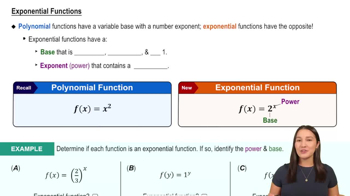Table of contents
- 0. Functions7h 52m
- Introduction to Functions16m
- Piecewise Functions10m
- Properties of Functions9m
- Common Functions1h 8m
- Transformations5m
- Combining Functions27m
- Exponent rules32m
- Exponential Functions28m
- Logarithmic Functions24m
- Properties of Logarithms34m
- Exponential & Logarithmic Equations35m
- Introduction to Trigonometric Functions38m
- Graphs of Trigonometric Functions44m
- Trigonometric Identities47m
- Inverse Trigonometric Functions48m
- 1. Limits and Continuity2h 2m
- 2. Intro to Derivatives1h 33m
- 3. Techniques of Differentiation3h 18m
- 4. Applications of Derivatives2h 38m
- 5. Graphical Applications of Derivatives6h 2m
- 6. Derivatives of Inverse, Exponential, & Logarithmic Functions2h 37m
- 7. Antiderivatives & Indefinite Integrals1h 26m
- 8. Definite Integrals4h 44m
- 9. Graphical Applications of Integrals2h 27m
- 10. Physics Applications of Integrals 2h 22m
5. Graphical Applications of Derivatives
The Second Derivative Test
Problem 4.3.82
Textbook Question
Second Derivative Test Locate the critical points of the following functions. Then use the Second Derivative Test to determine (if possible) whether they correspond to local maxima or local minima.
f(x) = eˣ(x - 2)²
 Verified step by step guidance
Verified step by step guidance1
First, find the first derivative of the function f(x) = e^x(x - 2)^2. Use the product rule: if u(x) = e^x and v(x) = (x - 2)^2, then f'(x) = u'(x)v(x) + u(x)v'(x).
Calculate the derivatives: u'(x) = e^x and v'(x) = 2(x - 2). Substitute these into the product rule to find f'(x).
Set the first derivative f'(x) equal to zero to find the critical points. Solve the equation for x to find the values where the slope of the tangent is zero.
Next, find the second derivative f''(x) by differentiating f'(x) again. This will involve using the product rule and chain rule as necessary.
Evaluate the second derivative at each critical point found. Use the Second Derivative Test: if f''(x) > 0, the point is a local minimum; if f''(x) < 0, the point is a local maximum. If f''(x) = 0, the test is inconclusive.
 Verified video answer for a similar problem:
Verified video answer for a similar problem:This video solution was recommended by our tutors as helpful for the problem above
Video duration:
7mPlay a video:
Was this helpful?
Key Concepts
Here are the essential concepts you must grasp in order to answer the question correctly.
Critical Points
Critical points of a function occur where its first derivative is zero or undefined. These points are essential for identifying potential local maxima and minima, as they represent locations where the function's slope changes. To find critical points, one must differentiate the function and solve for the values of x that satisfy the condition f'(x) = 0.
Recommended video:

Critical Points
Second Derivative Test
The Second Derivative Test is a method used to classify critical points as local maxima, local minima, or saddle points. It involves evaluating the second derivative of the function at the critical points. If f''(x) > 0, the point is a local minimum; if f''(x) < 0, it is a local maximum; and if f''(x) = 0, the test is inconclusive.
Recommended video:

The Second Derivative Test: Finding Local Extrema
Exponential and Polynomial Functions
The function f(x) = eˣ(x - 2)² combines an exponential function, eˣ, and a polynomial function, (x - 2)². Understanding the behavior of these types of functions is crucial, as exponential functions grow rapidly, while polynomial functions can have varying degrees of growth based on their degree. This knowledge helps in analyzing the overall shape and critical points of the function.
Recommended video:

Exponential Functions

 6:02m
6:02mWatch next
Master The Second Derivative Test: Finding Local Extrema with a bite sized video explanation from Callie
Start learningRelated Videos
Related Practice


